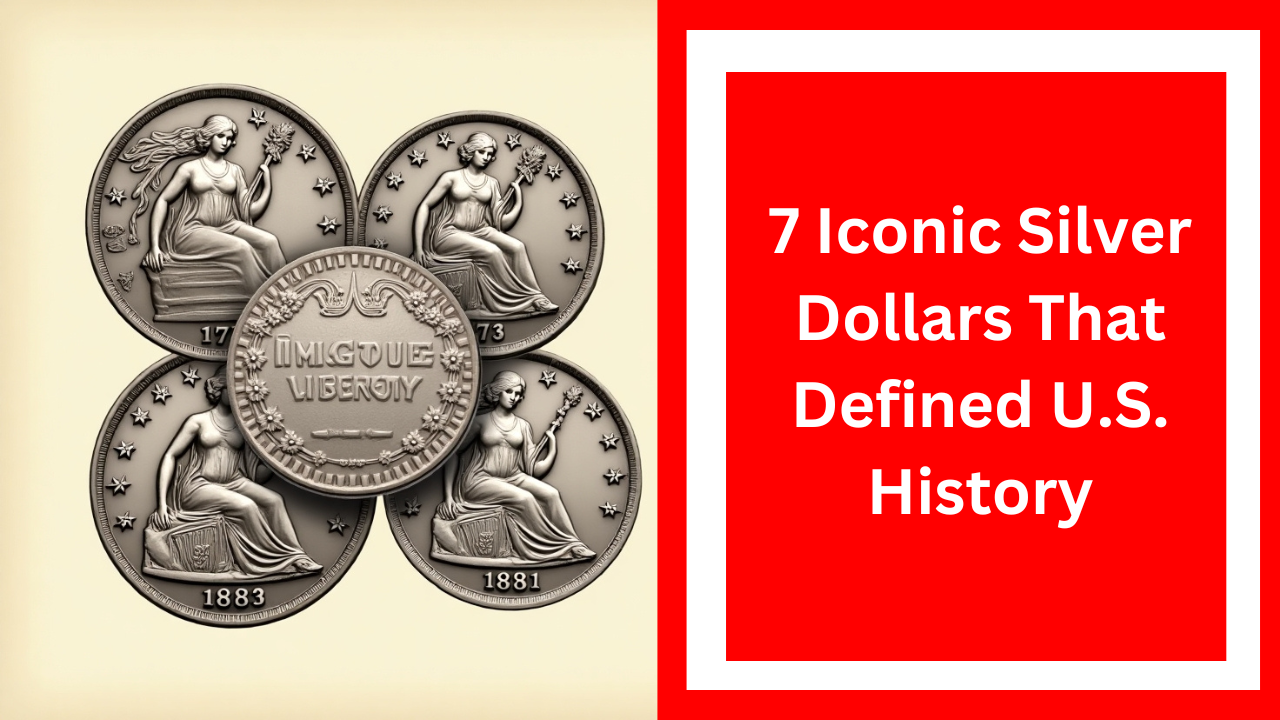7 Iconic Silver Dollars That Defined U.S. History: The history of U.S. silver dollars is as fascinating as the coins themselves, marked by periods of active production, pauses, and historical milestones. These coins reflect America’s evolving economy, legislative changes, and global aspirations, making them prized by collectors and historians alike.
The Early Years: 1794–1804
The story begins in 1794 with the Flowing Hair Dollar, the first silver dollar minted by the United States. This coin laid the foundation for America’s silver dollar legacy.
Production continued until 1804, but with an intriguing twist: the famous 1804 Draped Bust Dollar wasn’t minted in its designated year. Instead, it was struck in the mid-1830s, adding a layer of mystery to its allure.
Hiatus and Revival: 1836–1873
After a 30-year gap, silver dollar production resumed in 1836, ushering in new designs and adaptations to the nation’s shifting economic landscape.
However, this revival was short-lived. In 1873, the Coinage Act brought an end to the production of the then-current silver dollar, signaling another pause in the Mint’s history.
The Trade Dollar Era: 1873–1885
The introduction of the Trade Dollar in 1873 marked a unique chapter in U.S. coinage. Specifically designed for use in Asian commerce, this coin held limited legal-tender status domestically. Its primary purpose was to facilitate international trade, distinguishing it from silver dollars used within the United States.
The Morgan Dollar: 1878–1904, 1921
The Morgan Dollar, born from the Bland-Allison Act of 1878, became one of the most iconic silver dollars in U.S. history. Known for its widespread use, particularly in the Western states, this coin symbolized the resurgence of domestic silver dollar production.
Production ceased in 1904 but made a brief return in 1921, fulfilling the silver requirements of the Pittman Act of 1918.
The Peace Dollar: 1921–1935
In 1921, the Peace Dollar debuted as a tribute to the post-World War I peace efforts. Minted until 1928 and briefly revived in 1934–1935, this coin marked the end of regular U.S. silver dollar production. Its design and symbolism reflect the nation’s hope for lasting peace.
Timeline of Iconic Silver Dollars
| Design | Years Minted | Purpose | Notable Facts | Hiatus Periods |
|---|---|---|---|---|
| Flowing Hair Dollar | 1794–1795 | First U.S. silver dollar | 1794 specimen sold for $10M+ | — |
| Draped Bust Dollar | 1795–1804 | Continued early dollar design | Minted in 1830s with 1804 date | 1804–1836 |
| Seated Liberty Dollar | 1840–1873 | Revived dollar production | Ended by Coinage Act of 1873 | 1873–1878 |
| Trade Dollar | 1873–1885 | For Asian trade | Limited U.S. legal-tender status | — |
| Morgan Dollar | 1878–1904, 1921 | Domestic silver dollar revival | Brief 1921 production | 1904–1921; post-1921 |
| Peace Dollar | 1921–1928, 1934–1935 | Post-WWI peace commemoration | Final regular silver dollar | 1928–1934; post-1935 |
Conclusion
The journey of U.S. silver dollars is a tale of innovation, adaptation, and historical significance. From the groundbreaking Flowing Hair Dollar to the hopeful Peace Dollar, each coin tells a unique story of the nation’s economic and cultural evolution.
Collectors and enthusiasts treasure these coins not only for their rarity but also for their role in shaping America’s monetary legacy.
FAQ
- Q: When was the first U.S. silver dollar minted?
The first silver dollar, the Flowing Hair Dollar, was minted in 1794. - Q: Why wasn’t the 1804 silver dollar minted in 1804?
The 1804 Draped Bust Dollar was produced in the mid-1830s, despite bearing the 1804 date, making it an exceptional rarity. - Q: What was the purpose of the Trade Dollar?
Introduced in 1873, the Trade Dollar was primarily minted for commerce in Asia and held limited legal-tender status in the U.S. - Q: Why did silver dollar production stop after 1935?
Economic shifts and legislative changes led to the cessation of silver dollar minting, ending an era of regular production. - Q: What makes the Morgan Dollar significant?
The Morgan Dollar is celebrated for its historical importance, iconic design, and widespread use, making it a favorite among collectors.
